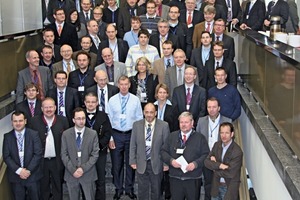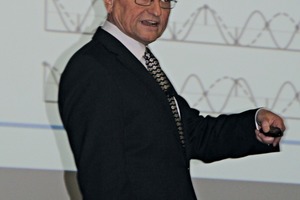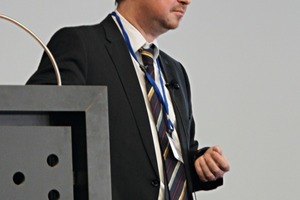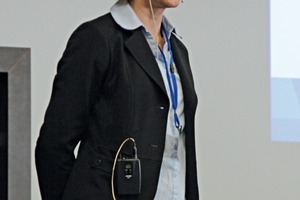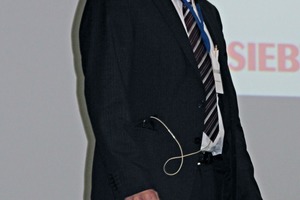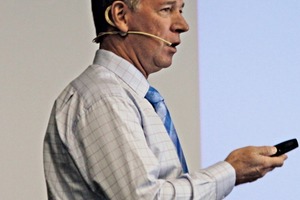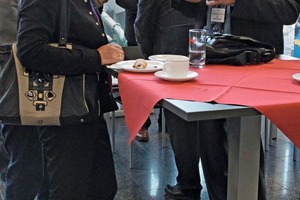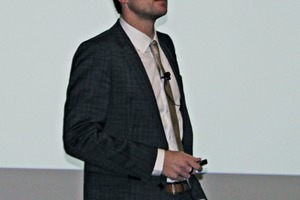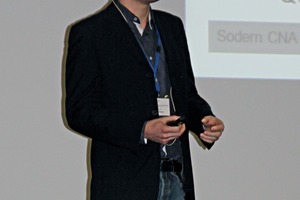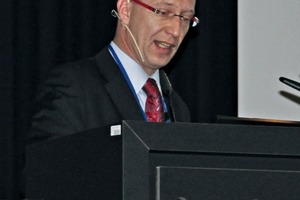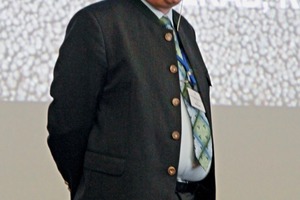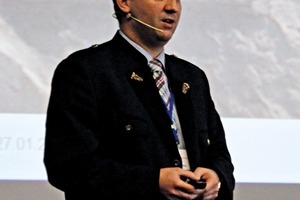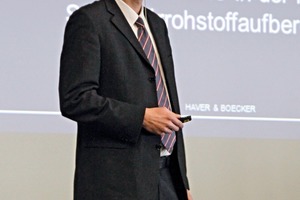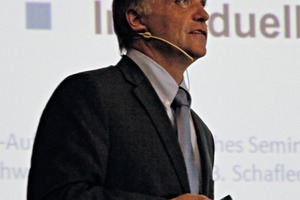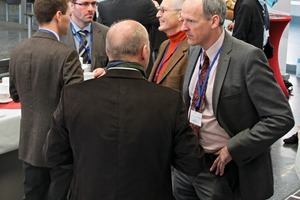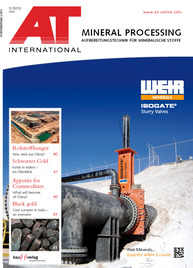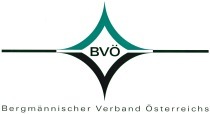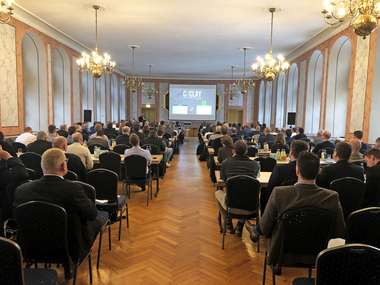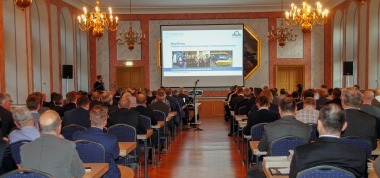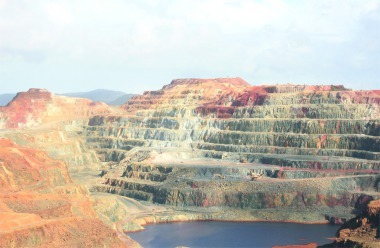Seminar on Mineral Processing 2012 at Leoben/Austria
Already for the tenth time in succes sion, the technical-scientific society of the Austrian Mining Association (BVÖ) joined together with the Mineral Processing Committee of the Austrian Mining Association (BVÖ) and the Montanuniversitaet Leoben to organize the two-day mineral processing seminar from 26 to 27 January in Leoben/Austria. At the centre of this year’s event was “Production Control in Mineral and Secondary Raw Material Processing” with regard to the physical and chemical characteristics and properties within product streams. In 18 papers, just fewer than 150 participating representatives from research, the basic industry and the supplier industry discussed the state of the art.
An introductory overview was provided by Prof. Dr. techn. Wolfhard Wegscheider, Chair of General and Analytical Chemistry at the Montanuniversitaet Leoben, in his talk on “Modern analysis processes for the mineral resources industry”. He emphasized the enormous importance of the definite identification of the composition and properties of raw materials before, but also during the process chain, to guarantee maximum efficiency in the workflow within mineral processing and to deliver a high-quality end-product. Ass.-Prof. Dr. mont. Andreas Böhm, Chair of Mineral Processing at the Montanuniversitaet Leoben, then described in his talk entitled “Material flow invariant for the design of incremental sampling equipment: background and case studies” the test-intensive procedure for statistically representative determination of material flow characteristics. A basic problem lies in the heterogeneity of the composition as well as the distribution of grains in the material streams to be sampled. To obtain representative information on the bulk sample, it is necessary to take into account corresponding characteristic error contributions, which result from the local material inhomogeneity, process-related variation errors in the individual samples and not least processing and analysis errors.
Following this introductory and theoretical approach to analysis methods, the speakers of the following lectures broached the advantages and benefits of fully automated sampling systems compared to the manual preparation of samples. In her talk “Things to consider when automating your lab”, Mette Dobel, FLS Minerals Industry, provided a practice-oriented overview of the work in an automated laboratory of a major company. She looked into the aspects that must be taken into consideration when converting a laboratory into an automated laboratory, e.g. in respect of technical equipment, integration of suitable manufacturers or a company’s own staff and what advantages fully automated sampling, etc. has for optimization of work safety, cost development and product quality. Dipl.-Ing. Jens Corell, Siebtechnik GmbH, showed in his paper “Possibilities for quality control with automated sampling and sample preparation systems” on the basis of case studies how the reliability of analysis results can be improved and so that the quality of bulk materials can be assessed more reliably in production or during handling. Customer-specific requirements play an important role in the development and installation of automated sampling and sample preparation systems. Daryl Stevens, FLS Essa, showed in his paper “Raw-material-adjusted automatic sampling systems: possibilities for bias-free sampling of bulk material with ESSA sampling systems” based on the use of automated sampling systems from ESSA, e.g. during port handling of iron ore or in a steelworks. He explained how far reliable and effective quality control can help companies to improve their competitive position.
In the next block of talks too, the focus overall was on the potential of modern analysis methods in respect of improving output and product quality. In his paper “From quarry to raw mill feed – importance of raw material properties”, Dipl.-Ing. Stéphane Ortega, Holcim Group Support Ltd, Holderbank AG, pointed out how much project success in limestone processing can depend on upstream analysis. Sampling, tests and evaluation are the basic precondition for the installation of a process chain adapted to the raw material for processing to finished product depending on the mineral composition, geologically related properties and seasonal influences (humidity, temperature). Juha Timperi, Outotec (Finland) Oy, then presented in his paper “Advanced control strategies in flotation circuits” the latest online process monitoring systems supplied by Outotec, which are used in addition to already installed basic control systems in flotation circuits. On the basis of various case studies (zinc, gold and copper extraction) he explained the optimized process flow. In her paper on the “Taking representative analysis samples from waste-derived fuels with the pressing drill method”, Prof. Dr.-Ing. Sylvia Schade-Dannewitz, Nordhausen University of Applied Sciences, then presented a newly developed method for sampling and obtaining analysis samples from heterogeneous bulk materials with low density. The pressing drill method achieves – compared with practised standard methods – a lower error rate in the analysis results and, besides being used for obtaining representative solid samples, it is also suitable for differentiated chlorine analysis.
In the last block of talks of the first day, other analysis systems for material streams were presented by equipment manufacturers. Carsten Wiedmann, Thermo Fisher Scientific Messtechnik GmbH, presented in his paper on “Product stream control with PGNAA – possibilities and limitations in comparison with incremental sampling” the Thermo Scientific CB Omni as the latest generation in Prompt Gamma Neutron Activation Analysis (PGNAA) systems. With the Cross Belt Analyzer, which is generally used in cement works for control of the deposit, metering control upstream of the raw mill and material sorting, real time analyses can be performed on raw material compositions and total material flow analyses can be performed irrespective of errors in connection with sampling. Jerome Gondeau, PANalytical B.V., reported in his paper “The Sodern CNA – technique, applications” on possibilities and benefits of controlled neutron analysis compared with X-ray analysis based on the example of typical applications in the cement and coal industry or in the extraction of mineral resources such as copper, nickel and iron ore. The particle analyser OPUS, which operates on the basis of ultrasonic extinction, was at the focus of the paper “On-line particle size analysis in mineral processing operations, state of the art and case studies” presented by Dipl.-Ing. Axel Pankewitz, Sympatec GmbH. Besides being used for determination of particle size distribution, OPUS is also suitable for the measurement of the solids content of mineral sludges directly in rough process environments. The high-resolution analysis results provide a multitude of data for overall process and product control.
Determination of material flow characteristics and material flow contents within the product streams is the precondition for obtaining a high-quality and consistent final product with optimum utilization of the available raw material, especially as the quality of the raw material within the different deposits can vary considerably. So the second day of the event also focussed on the issue of how far product flow control can be improved with the help of analysis processes. Kari Niiranen, MSc., LKAB, Kiruna reported in his paper “Product flow control of the feed flow in mineral processing at LKAB/Kiruna” on the development of a simplified process on laboratory scale, with the help of which the processing properties of the extracted ore can be predicted. After the different types of ore (low phosphorous, high phosphorous) were put together for production reasons already during extraction and the previous sampling underground already eliminated, now physical values of the extracted ore determined based on processing tests and chemical analysis were implemented in a geological 3D model, which serves an information base for the control of the mineral processing and handling chain. In his paper “Online analysis for process control in voestalpine steel”, Dipl.-Ing. Karl Pilz, voestalpine Stahl GmbH, presented three measuring systems that after a complex phase of development, installation and commissioning are prototypes in their respective field of application. With the goal of optimized heating of the coke batteries, online measurement of the fed coal mix with XRF (X-ray fluorescence analysis) was successfully installed. With the help of online XRF, it is also possible to classify the LD dust formed during steel production based on the determined zinc content. Online measurement of the LD slag with LIBS (Laser-Induced Breakdown Spectroscopy) enables definite classification of the quality of the LD slag on the basis of chemical analysis. The measures already implemented for “Production control at the Styrian Erzberg” with a view to a long-term assurance of the utilization of the deposit were the topic of the paper presented by Dipl.-Ing. Dr. mont. Alfred Stadtschnitzer, VA Erzberg GmbH. Besides the acquisition of an X-ray fluorescence spectrometer for optimization of measurement time and measurement accuracy, the use of an online analyser for determination of the qualities of the currently mined ore at the input stream and a sensor-assisted sorter on the basis of an X-ray fluorescence spectrometer should be mentioned. In addition, for quality assurance in the homogenization pile, a mechanical mixing bed is planned and with an additional sampling point the composition of the material can be constantly updated. With the help of these measures, it is possible to optimally feed the existing mineral processing lines and react faster to changing quality during the entire process chain to the delivery of the finished product.
The “Photooptical particle analysis (HAVER-CPA), applications and possibilities in mineral processing” was the focus of the paper presented by Dipl.‑Ing. (FH) Sven Vennewald, Haver & Boecker OHG, Oelde. The HAVER CPA measurement process delivers results comparable with conventional screen analysis and offers other advantages, like, for example, fast detection of the particle size, particle shape characteristic values and particle numbers, time and cost saving during measurement, individual evaluation of the product and particle data, early detection of the start-up, transitional and stationary ranges in production processes, easy archiving and comfortable data handling, high reproducibility of the measurement results, etc. Thanks to a large number of HAVER periphery devices, the CPA systems can be extended so that they can be used as laboratory, pilot plant or online version for a wide range of applications – e.g. in the coke/coal industry, sand and gravel industry or in the chemicals industry. Dipl.-Ing. Christian Makari, binder+co AG, reported in his paper “Production Control in a modern waste glass processing plant – impact number statistics of sensor-assisted sorting machines and volume flow for automatic production optimization” on the use of an intelligent control system. With the help of this higher-level automatic control system for control and optimization of production, continuous production quality, a constantly high finished product quality, optimum throughput rate, efficient sorting conditions for sensor-assisted machines, minimization of the operating effort for operation of the plant, low additional investment costs and consequently high economic efficiency can be achieved. Dipl.-Ing. Peter Schwei and Dipl.-Ing. Walter Steinwender, w&p Zement GmbH, presented in their paper “Processing and quality-assured use of waste-derived fuels in Portland cement clinker production at the Wietersdorf plant” a new concept for fuel processing, sample preparation and sampling as well as analysis. To meet limits in accordance with the new version of the waste incineration ordinance, e.g. sampling frequency, sample division as well as other analysis methods have been put on a new statistical basis. As a result it is possible to produce clinkers with high quality and at the same time to meet additional requirements with the existing production and laboratory staff. To conclude the series of papers, Dipl.‑Ing. Dr. mont. Wolfram Bernhart, METSO MCT – Process Technology Development, gave in his paper “Trends in the control of mineral processing systems” an overview of developments in process control based on projects in the mining industry realized by Metso over the last two decades. Thanks to the increasing capability of computer technology, it is now possible to enter and process large volumes of data. With the help of phenomenological models and process control based on models (Model Predictive Control), more and more complex and efficient control strategies can be developed and processes controlled. At the same time, with the help of imaging sensors in a wide range of the process stages in mineral processing, control efficiency can be improved. Equally, data mining and the use of dynamic simulation programs provided the basis for new applications in process control. A limit to the feasible is not in sight – on the contrary the development in this area is completely open upwards.
Against this background both in the breaks between the individual lecture sessions and in two evening events, the participating professionals in the minerals and waste-derived raw materials industry, the machine manufacturers and plant engineering companies, as well as students and lecturers at universities were given ample opportunity for lively transfer of information. The state of the art and the limitations to the use of modern analysis methods for material stream and production flow control and their future-oriented potential was examined both intensively and critically. An exhibition was integrated in the course of the seminar to offer companies in the minerals and secondary raw materials industry, equipment manufacturers, plant suppliers and the university the possibility to exhibit innovations related to the subject of the seminar and here too to use the opportunity for lively exchange of experience.

